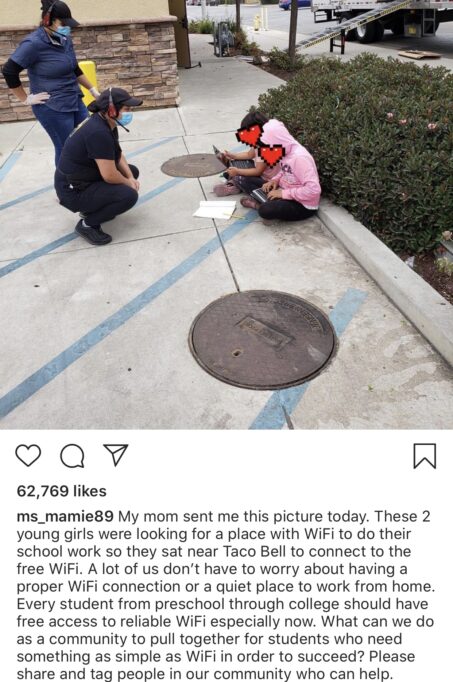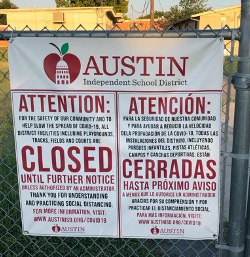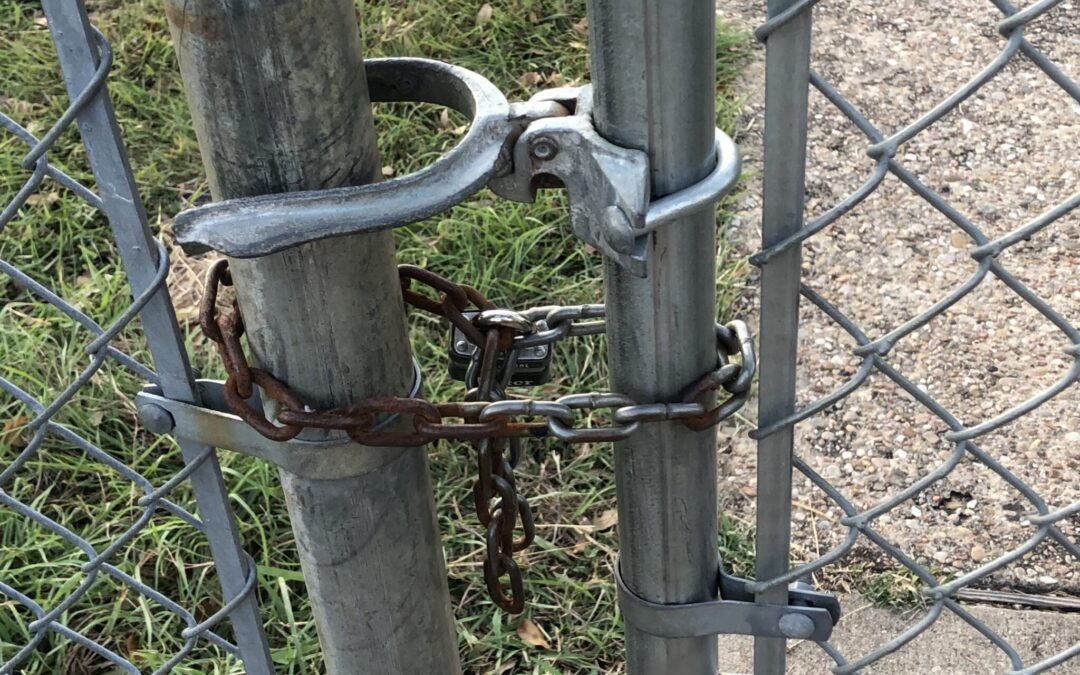Austin Independent School District was slated to begin instruction on August 18th, 2020. In July, when COVID-19 rates were spiking in Austin and across the state, the district decided that the first four weeks of classes would be conducted 100% virtually. There are a broad range of adjusted start times and virtual options for many schools in the Austin area, and in some schools remote instruction is in full swing. Rounding the corner on the second school year impacted by the novel Coronavirus COVID-19, some parents in my neighborhood Facebook group are posting about seeing families in East Austin using McDonald’s Wi-Fi to complete electronic homework. The Facebook conversation began when someone shared a photo of two young girls in a Salinas, California Taco Bell parking lot trying to do their homework. Instagram user @ms_mamie89 shared the photo on her page with public visibility, her caption explaining that many students- from college to kindergarten- do not have a place to connect. She urged her Instagram followers to share the photo to bring attention to the fact that many students still lack a safe and reliable place to complete electronic homework.

In an earlier blog post, I wrote about the fact that during the first wave of pandemic-related school closures in March of 2020, students went “missing” and did not log in to virtual classes or engage with their school-provided devices. in Austin, half of students who needed Chromebooks could not be contacted by the district through telephone or electronic means. The anecdotes from some parents in my neighborhood sharing their observations that kids are sitting outside McDonald’s to do homework suggests the issue of connectivity persists in Austin.
If virtual schooling is near-ubiquitous, why are some families still unconnected? The answer typically falls into two categories: families cannot get a connection where they live, or the cost of broadband is simply unsustainable.
On May 1, 2020, I defended my dissertation which focused on “The Homework Gap”, describing the achievement gap that students face when they leave school and are unable to complete their homework because they lack access to broadband. One of the major themes that arose from speaking to parents is that many are still astonished at the high price of Internet service, the majority of families citing they pay close to $100 per month for the broadband their children need. In fact, only one of the parents in the sample felt his fixed wireless service was a fair price, but he also had the lowest broadband bill in the study, only paying $35 per month. Low income families felt the pressure of Internet bills were out of touch with their reality:
Jacque: I find it’s getting too outrageous. Because when you take a plan with the company, they tell you, “Oh dear, it starts at $10.99” three months pass and you see what kind of tax and everything is counting up. Four months and they say, “Oh, we have to add this and that.” Five months, six, and “Oh well, what we gave you is finished.” So then when you realize that you’re almost paying $70 or $80 a month. And I can’t afford to pay that for just Internet. Crazy.
Laura: (Translating for another adult patron in response to Jacque) Paulina agrees it’s crazy, “mucho tanto”, because the kids need it for school, and sometimes she don’t have no money to pay for the Internet bill. And I say the same thing. It’s too much money for Internet. Only Internet! Not – you don’t – you could get the three: Internet, phone and cable. But it’s still too much money.”
Costs associated with broadband seem to perpetually increase and parents observed these rate hikes came without warning or justification. In many families, these rates were unsustainable. In other families, some parents cycled in and out of broadband or cell phone service in response to financial pressures that arose throughout the year. The cycle of intermittent broadband access remains somewhat hidden; many families experience financial precarity that is uncaptured in annual statistics due to the fact that stresses pop up in smaller intervals of time. The present pandemic crisis in the United States is a major cause of economic stress, and scholars at the Columbia Population Research Center predict that in the coming months, upwards of 21 million individuals could be living in poverty for the year, a level the nation has not experienced for over 50 years.
The fact remains that families still experience barriers to connection, and a lack of connection is pushing them to use broadband in public spaces where their neighbors are realizing the extent of underservice in their communities. In Austin, there are other confounding local factors that may drive families to McDonald’s parking lots. This crowd-sourced map of public Wi-Fi networks in Austin displays a dearth of access points in my neighborhood, but also in East and Southeast Austin where many low-income families reside. Zooming the map out, a pattern is distinct: public access points and private businesses providing broadband to their customers are clustered to the west of I-35. The map bears a striking resemblance to this visualization by Laurel Joseph, highlighting the presence of food deserts in Austin. Lacking broadband access often intersects with barriers to critical services and infrastructures like health care, and quality schools.
Public libraries in Austin remain closed due to COVID-19 public health concerns and removes the technology and tools safety net some parents might have counted on. I called the Austin Public Library to find out if wireless is available outside the building in the parking lot and what hours the wireless service is open to the public. Librarians at the branches that are near my house (Windsor Park and University Hills) explained that Wi-Fi signals are not very strong beyond the walls of the building. One of the librarians walked out to the parking lot with a computer to test the signal while I chatted with him on the phone. He did suggest, however, that the network was available from 6:00 AM to 11:00 PM, and stays on after the library branch closes at 6 PM.
Another source of wireless Internet that should be available to families with children in AISD schools are wireless networks at the schools themselves. During the early months of the pandemic, the elementary school close to my house, Pecan Springs Elementary, enabled guest Wi-Fi access. The signal was robust enough to reach the playground, basketball court, and exercise track.

The park is a dual-use between AISD and the Parks and Recreation department (PARD). However, because of COVID-19 restrictions, school facilities have been placed under lock and key. Recently, an AISD police officer parked outside the locked gate in the evening to ensure no one would access the space. I called 3-1-1 today to inquire when other park facilities would reopen, and the operator suggested that https://austintexas.gov/page/pard-facilities-closures was my best resource for that information because no date for reopening has been set.
Tennis courts, trails, and boat launches remain open. If trails and tennis courts are open, why not consider unlocking these large outdoor spaces around schools so children can complete virtual homework?
Neighborhood Elementary schools are dispersed throughout Austin, representing easy-to-reach enclaves for families who may already be familiar with the campuses. The balance between the fear of spreading the coronavirus on playground surfaces weighs heavy into the decision to lock facilities. However, it is clear that there are resources to police spaces from being accessed. Why not mobilize those same resources to ensure families are staying both safe from harm while using wireless networks, and staying healthy while enjoying time outside?
Until Austin opens more networks and unlocks more of our Wireless-enabled parks, we will keep hearing stories of children sitting in McDonald’s parking lots… not because they are enjoying a happy meal, but instead because they are trapped with few other options to participate in virtual school.

